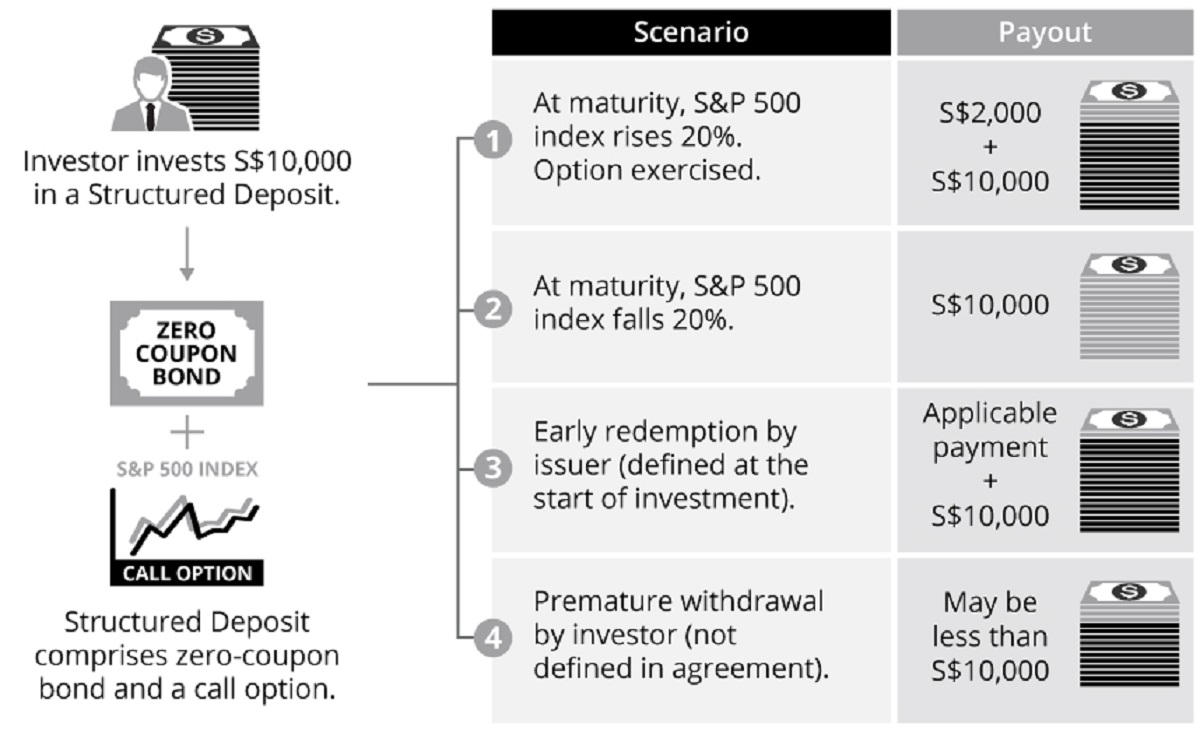Introduction
Structured investments are a popular financial instrument that offers investors the opportunity to diversify their portfolios and potentially earn higher returns. They are a combination of different financial instruments, such as bonds, equities, and derivatives, packaged into a single investment product. These structured investments are designed to provide investors with a tailored investment strategy that aligns with their financial goals and risk appetite.
Structured investments gained popularity in recent years due to their ability to offer potentially higher returns than traditional investment options. They are favored by both individual and institutional investors who are looking for alternative investment opportunities beyond traditional stocks and bonds.
What sets structured investments apart from conventional investments is their unique structure and payout mechanism. They are often built around specific underlying assets or indexes, and their performance is linked to the performance of these assets or indexes. Structured investments have predefined terms and conditions, including a fixed investment period, and the potential returns are determined based on how the underlying assets or indexes perform during that period.
The appeal of structured investments lies in their ability to offer potential upside while providing downside protection. They can be structured to offer a guaranteed minimum return or a partial capital protection, which means that the investor will receive a percentage of their initial investment, even if the underlying assets or indexes perform poorly.
In this article, we will delve deeper into the world of structured investments. We will explore how they work, the different types available, the potential benefits they offer, and the risks associated with investing in them. We will also provide some guidance on how to invest in structured investments and make informed decisions.
By understanding structured investments and how they fit into your investment strategy, you can make well-informed decisions that align with your financial goals and risk tolerance. So, let’s dive in and explore the fascinating world of structured investments.
What are Structured Investments?
Structured investments are complex financial products that are comprised of multiple underlying assets, such as stocks, bonds, and derivatives. They are designed to offer investors a tailored investment solution that combines elements of different asset classes.
At their core, structured investments are an agreement between an investor and a financial institution. The investor provides a certain amount of funds, and in return, the financial institution creates a custom investment vehicle based on the investor’s objectives and risk tolerance.
The structure of these investments can vary widely, depending on the investor’s preferences and the market conditions. They can be linked to various asset classes, such as equity indices, commodities, interest rates, or foreign exchange rates. The potential returns of the investment are determined by the performance of these underlying assets.
One of the key features of structured investments is that they often incorporate some form of protection or downside risk management. This can be in the form of a guaranteed minimum return, a capital protection feature, or a partial refund of the principal investment.
The payout structure of structured investments is also unique. Instead of offering a fixed rate of return, the returns are typically linked to the performance of the underlying assets or indices. This can result in a variable return, offering the potential for higher profits if the underlying assets perform well.
Structured investments can be appealing to investors who want to diversify their portfolios and potentially achieve higher returns than traditional investment options. They can also be attractive to investors who are seeking specific investment outcomes, such as income generation or capital growth.
However, it’s important to note that structured investments are not suitable for everyone. They are complex financial products that require a good understanding of their terms, conditions, and risks. It’s crucial for investors to carefully evaluate the associated costs, potential returns, and risks before investing in a structured product.
In the next section, we will explore how structured investments work and delve into the different types available in the market.
How Structured Investments Work
Structured investments operate on a unique framework that combines various financial instruments to create a customized investment product. These investments are typically offered by financial institutions, such as banks and investment firms, and are tailored to meet the specific needs and objectives of individual investors.
When investing in structured investments, investors provide a certain amount of capital, which is then used to create the investment product. The structure of the investment is based on the investor’s preferences, risk appetite, and market conditions.
The underlying assets or indices that form the basis of the investment’s performance are carefully selected. They can include stocks, bonds, commodities, or other financial instruments. The performance of these underlying assets or indices directly impacts the returns of the structured investment.
Structured investments can have various payout structures depending on the terms and conditions defined at the time of investment. Some structured investments offer a fixed rate of return, while others provide a variable return based on the performance of the underlying assets or indices.
Structured investments often include some degree of downside protection to mitigate the risks involved. This protection can be in the form of a guaranteed minimum return, capital protection, or a partial refund of the initial investment.
The investment period of structured investments is predetermined and can range from a few months to several years. At the end of the investment period, investors may receive the full principal investment amount along with a defined return, or the return may be based on the performance of the underlying assets or indices.
It’s important to note that the terms and conditions of structured investments can vary significantly. Each investment product may have its own set of features, risks, and potential returns. Investors should carefully review the offering documents and prospectus provided by the financial institution to fully understand the details of the investment before making a decision.
Structured investments are typically offered to both individual and institutional investors. They provide an opportunity to diversify investment portfolios and potentially earn higher returns than traditional investment options. However, they come with their own set of risks, and investors should assess their risk tolerance and investment objectives before investing.
In the next section, we will explore the different types of structured investments available in the market.
Types of Structured Investments
Structured investments come in various forms, each with its own characteristics and potential returns. Here are some of the common types of structured investments available in the market:
- Structured Notes: These are debt obligations issued by financial institutions. Structured notes are linked to the performance of underlying assets or indices and offer a fixed or variable return based on their performance. They can provide capital protection or downside risk management features, making them suitable for investors seeking risk mitigation.
- Equity-Linked Investments: These investments are linked to the performance of a specific stock or a basket of stocks. They offer the potential for higher returns based on stock price movements. Equity-linked investments can have features like capital protection levels or downside buffers to limit exposure to market volatility.
- Commodity-Linked Investments: These investments are linked to the performance of commodities, such as gold, oil, or agricultural products. They provide exposure to commodity price fluctuations and can offer potential returns based on the performance of the underlying commodity. Commodity-linked investments can be beneficial for investors looking to diversify their portfolios beyond traditional asset classes.
- Index-Linked Investments: These investments are tied to the performance of a specific financial index, such as the S&P 500 or the FTSE 100. Index-linked investments allow investors to gain exposure to the broader market without investing directly in individual stocks. They offer the potential for returns based on the index performance, with various levels of downside protection or risk mitigation mechanisms.
- Currency-Linked Investments: These investments are linked to the exchange rates of different currencies. They provide exposure to currency movements and can offer potential returns based on the performance of the selected currency pair. Currency-linked investments can be attractive to investors seeking diversification and potential gains from currency fluctuations.
- Hybrid Structured Investments: These investments combine multiple elements, such as equities, bonds, commodities, or derivatives, into a single structured product. Hybrid structured investments offer a more diversified investment approach and can provide a tailored solution to investors’ specific needs and objectives.
These are just a few examples of the types of structured investments available. It’s important to note that each structured investment has its own terms, conditions, and potential risks. Investors should carefully review the offering documents and consult with a financial advisor to understand the features and risks associated with each type before making an investment decision.
In the next section, we will discuss the potential benefits of investing in structured products.
Benefits of Structured Investments
Structured investments offer several potential benefits for investors who are looking to diversify their portfolios and explore alternative investment options. Here are some of the key benefits associated with structured investments:
- Diversification: Structured investments provide an avenue for diversification beyond traditional investments like stocks and bonds. By combining different asset classes or indices into a single investment product, structured investments allow investors to spread their risk and potentially enhance their portfolio performance.
- Tailored Investment Strategy: One of the main advantages of structured investments is their ability to be customized according to the investor’s specific goals and risk appetite. Financial institutions can design structured investment products based on the investor’s desired exposure, return expectations, and risk tolerance. This tailor-made approach ensures that the investment aligns with the investor’s individual objectives.
- Potential for Higher Returns: Structured investments offer the potential for higher returns compared to traditional investment options. By combining different financial instruments or indexes, structured investments can tap into opportunities for growth and market outperformance. Investors can benefit from market upside while still having the option for downside protection or risk management.
- Downside Protection: Many structured investments include features that provide some level of downside protection. This can include capital protection, partial principal repayment, or guaranteed minimum returns. These protective features offer a measure of security to investors, limiting potential losses even in adverse market conditions.
- Increased Access to Specialized Assets or Strategies: Structured investments often provide access to specialized assets or investment strategies that may not be readily available to individual investors. For example, they may offer exposure to alternative investments like commodities or hedge funds. By investing in structured products, investors can benefit from the expertise and strategies employed by professional portfolio managers.
- Tax Efficiency: Structured investments can also provide tax-efficient investment opportunities. Some structured investments offer tax advantages, such as capital gains tax deferral or tax-efficient income generation strategies. These tax benefits can enhance overall investment returns for investors.
It’s important to note that while structured investments offer various potential benefits, they also come with their own set of risks. Investors should carefully consider their individual financial situation, risk tolerance, and investment objectives before investing in structured products.
In the next section, we will discuss the potential risks associated with investing in structured investments.
Risks of Structured Investments
While structured investments offer potential benefits, it’s important for investors to be aware of the associated risks. Here are some of the key risks to consider when investing in structured products:
- Market Risk: Structured investments are inherently exposed to the performance of the underlying assets or indices they are linked to. If the market experiences significant volatility or a downturn, the value of the structured investment may decline, potentially resulting in losses for the investor.
- Liquidity Risk: Depending on the specific structure of the investment, it may be challenging to sell or exit the investment before the predetermined maturity date. Limited liquidity can be a concern, especially in situations where the investor may need immediate access to their funds.
- Counterparty Risk: Structured investments are typically created by financial institutions, and their performance is dependent on the creditworthiness of these institutions. In the event of a default or bankruptcy of the issuing institution, investors may not receive the expected returns or even lose their entire investment.
- Complexity: Structured investments can be complex financial products that may be difficult for some investors to fully understand. They often involve intricate terms, conditions, and payout calculations. Investors should carefully review the offering documents and seek guidance from financial professionals before investing.
- Costs: Structured investments may come with various fees and charges, including entry fees, management fees, and redemption fees. These costs can eat into the overall returns of the investment and should be considered when evaluating the potential profitability of the structured product.
- Regulatory Changes: The regulatory landscape for structured products may change over time. New regulations or changes in existing regulations can impact the structure, terms, and potential returns of structured investments. Investors should stay informed about any regulatory developments that may affect their investments.
It’s important for investors to carefully assess their risk tolerance, investment goals, and financial situation before investing in structured products. It’s also recommended to consult with a financial advisor who can provide personalized guidance and help navigate the complexities and risks involved in investing in structured investments.
In the next section, we will explore how investors can participate in structured investments and make informed investment decisions.
How to Invest in Structured Investments
Investing in structured products requires careful consideration and understanding of the investment process. Here are some steps to follow when looking to invest in structured investments:
- Educate Yourself: Start by gaining a solid understanding of what structured investments are, how they work, and their associated risks and potential returns. Research online resources, read books, and consult with financial professionals to enhance your knowledge.
- Define Your Investment Goals: Clarify your investment objectives, risk tolerance, and time horizon. Determine what you aim to achieve with your investment in terms of potential returns, asset allocation, and diversification.
- Assess Your Financial Situation: Evaluate your financial circumstances, including your liquidity needs and investment capital. Structured investments often require a minimum investment amount, so ensure that you have the necessary funds available.
- Consult with a Financial Advisor: Seek guidance from a qualified financial advisor who specializes in structured investments. They can provide personalized advice based on your investment goals and help you navigate the complexities of structured products.
- Research Available Options: Explore different structured investment offerings from reputable financial institutions. Consider factors such as the underlying assets or indices, potential returns, downside protection features, liquidity, and costs associated with the investment.
- Review Offering Documents: Thoroughly review the offering documents, prospectus, and terms and conditions provided by the financial institution offering the structured investment. Pay close attention to the investment’s payout structure, maturity date, fees, and any associated risks.
- Diversify Your Portfolio: Evaluate how structured investments fit into your overall investment portfolio. Consider diversifying your portfolio across different asset classes, including stocks, bonds, and structured products, to spread risk and potentially enhance returns.
- Monitor Your Investment: Once you have invested in a structured product, regularly monitor its performance and stay informed about any updates or changes related to the investment. Stay in touch with your financial advisor to review your investment strategy periodically.
- Consider Tax Implications: Consult with a tax professional to understand the potential tax implications of your structured investments. Tax rules may vary depending on the type of investment and your jurisdiction, so it’s important to understand the tax consequences of your investment.
Remember, investing in structured products involves risks, and it’s important to fully understand the terms, conditions, and potential outcomes before committing your funds. Seek professional advice, conduct thorough research, and make informed decisions based on your own financial goals and risk tolerance.
In the next section, we will conclude our exploration of structured investments and summarize the key points discussed.
Conclusion
Structured investments offer investors a unique opportunity to diversify their portfolios with a custom-tailored investment strategy. These investments combine different financial instruments and provide potential for higher returns, downside protection, and exposure to specialized assets or strategies. However, they also come with risks that should be carefully considered.
By understanding how structured investments work, the different types available, and the potential benefits and risks involved, investors can make more informed investment decisions. It is crucial to educate oneself, define investment goals, assess financial situation, and seek guidance from financial professionals who specialize in structured investments.
Furthermore, investors should carefully review offering documents, evaluate the payout structure, consider costs, and ensure adequate diversification within their investment portfolios. The ability to monitor investments, stay informed about market conditions, and understand potential tax implications is also essential.
Structured investments can be a valuable addition to an investor’s portfolio but require careful due diligence and an understanding of the associated risks. By approaching these investments with caution and seeking professional advice, investors can potentially benefit from the unique advantages that structured investments offer.
Ultimately, each investor’s financial situation and risk tolerance will determine whether structured investments are suitable for their investment goals. It is important to thoroughly evaluate individual circumstances and objectives before making any investment decisions.

























